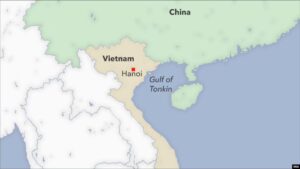Prelims – Places in News (World)

The Gulf of Tonkin has recently been in the spotlight due to geopolitical developments in the region.
Geographical Overview
The Gulf of Tonkin is a crescent-shaped, shallow, semi-enclosed body of water located in the northwestern part of the South China Sea. In regional nomenclature, it is referred to as the ‘Beibu Gulf’ in China and the ‘Bac Bo Gulf’ in Vietnam.
Borders and Connectivity
- It is bordered by China to the north and east, Vietnam to the west, and Hainan Island to the east.
- The southern outlet of the gulf connects it to the South China Sea, while the Qiongzhou (Hainan) Strait in the northeast offers another maritime link.
Hydrological and Maritime Features
- The Red River, originating in China and flowing through Vietnam, drains into the gulf.
- Prominent ports located along its coastline include Ben Thuy and Haiphong in Vietnam, and Beihai (Pakhoi) in China.
Historical Relevance
The Gulf of Tonkin Incident in 1964 was a pivotal moment in Cold War history. It led to the Gulf of Tonkin Resolution being passed by the US Congress, which significantly escalated American military involvement in the Vietnam War (1954–1975).




